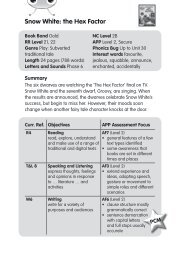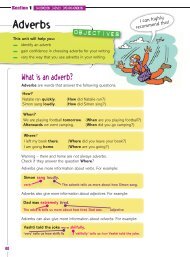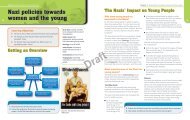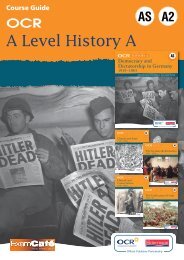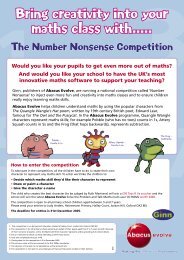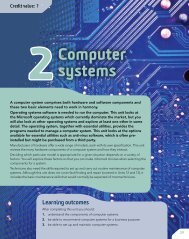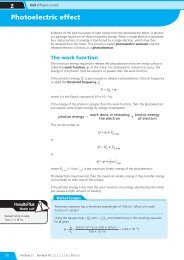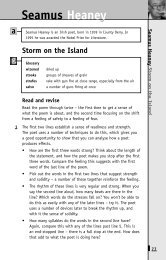Unit 1 Developing effective communication in health and social care
Unit 1 Developing effective communication in health and social care
Unit 1 Developing effective communication in health and social care
You also want an ePaper? Increase the reach of your titles
YUMPU automatically turns print PDFs into web optimized ePapers that Google loves.
BTEC Level 3 National Health <strong>and</strong> Social Care<br />
Activity sheet answers<br />
AS1<br />
Types of <strong>in</strong>terpersonal <strong>in</strong>teraction<br />
<strong>Unit</strong> 1 <strong>Develop<strong>in</strong>g</strong> <strong>effective</strong> <strong>communication</strong> <strong>in</strong> <strong>health</strong><br />
<strong>and</strong> <strong>social</strong> <strong>care</strong><br />
There are no set answers. Learners are encouraged to consider their own skills <strong>and</strong> express their own views.<br />
Th<strong>in</strong>k about mak<strong>in</strong>g a contract with learners concern<strong>in</strong>g confidentiality with<strong>in</strong> the class <strong>and</strong> develop a sense of<br />
safety before beg<strong>in</strong>n<strong>in</strong>g.<br />
AS2<br />
Assess<strong>in</strong>g your own skills<br />
There are no set answers. Learners are encouraged to assess their own skills <strong>and</strong> those of their peers. As with<br />
AS1 Types of <strong>in</strong>terpersonal <strong>in</strong>teraction, consider safety issues <strong>and</strong> encourage constructive feedback between<br />
learners.<br />
AS3<br />
Non-verbal <strong>communication</strong>: Personal space<br />
Us<strong>in</strong>g the figure on page 13 of the Student Book 1, learners can put theory <strong>in</strong>to practice by consider<strong>in</strong>g how<br />
each of the personal space issues affects them personally.<br />
Small group discussions: Learners can be encouraged to consider the needs of the client <strong>in</strong> each scenario<br />
<strong>and</strong> how this may sometimes clash with their duty of <strong>care</strong>.<br />
AS4<br />
Assess your own non-verbal skills<br />
H<strong>and</strong>s on hips Aggression or read<strong>in</strong>ess<br />
Sitt<strong>in</strong>g with legs crossed Boredom or defensive<br />
Sitt<strong>in</strong>g with legs apart Open <strong>and</strong> relaxed<br />
Arms crossed on chest Defensive<br />
H<strong>and</strong> on cheek Th<strong>in</strong>k<strong>in</strong>g, evaluat<strong>in</strong>g<br />
Touch or rubb<strong>in</strong>g the nose Ly<strong>in</strong>g, doubtful<br />
Rubb<strong>in</strong>g the eye/s Disbelief, doubtful<br />
Open palm/s Openness, s<strong>in</strong>cerity<br />
Touch<strong>in</strong>g hair Lack of self-confidence<br />
Steepled f<strong>in</strong>gers Authoritative<br />
AS5<br />
Factors that <strong>in</strong>fluence <strong>communication</strong> <strong>and</strong> <strong>in</strong>terpersonal<br />
<strong>in</strong>teraction<br />
Accept any suitable answers, <strong>in</strong>clud<strong>in</strong>g: type of <strong>communication</strong> (written, verbal, sign language, electronic);<br />
cultural differences, different languages spoken; the environment where the <strong>communication</strong> takes place,<br />
attitudes, ability to respond, disability; content of <strong>communication</strong>, sensitive issues, emotional needs, selfesteem.<br />
© Pearson Education Ltd 2010. Copy<strong>in</strong>g permitted for purchas<strong>in</strong>g <strong>in</strong>stitution only. This material is not copyright free. 1



